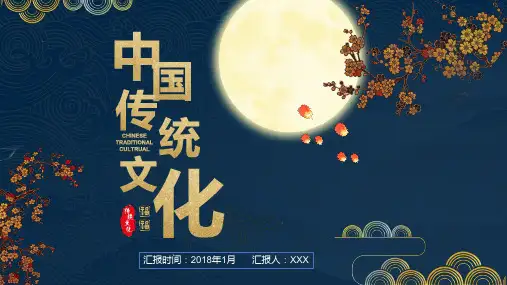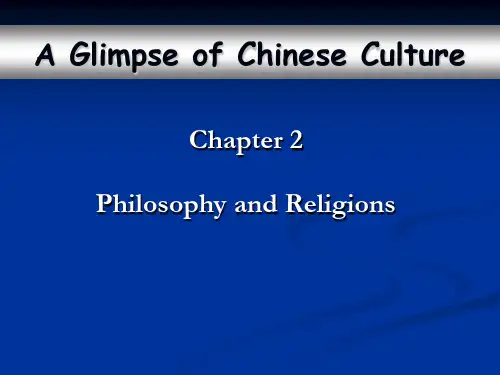中国文化概况Chapter1 ppt
- 格式:ppt
- 大小:6.37 MB
- 文档页数:48

中国文化概况PPTword版2011-6-6说明:由于西区网络缘故,所发PPT打不开,现将课堂内容PPT转成word版,以此减少笔记的压力。
A Glimpse of Chinese Culture学生版1About This Course▪Time: 24 hours, 2 hours/week,12 weeks.▪Objectives:1)Getting a better understanding of Chinese culture;2)Getting to know the key terms in Chinese culture and their English expressions;3)Obtaining a comparative perspective in Chinese culture4)Cultivating a critical attitude towards Chinese culture▪Requirements1)Class attendances2)Active participation3)Final examinationAbout the Final ExaminationI. Give brief statements to the following topics (20%)II. Fill in the following blanks (20%)III. True or False. (20%)IV. Discuss the following two topics no less than 200 hundred words each. Both English and Chinese are acceptable(40%)注明:1、课程总评计分按学校规定,采用百分制,其中卷面占70%,平时30%。
平时成绩考评,按教务规定。
2、考虑到大一的语言能力表达有限,试卷作答允许中文,但文化现象分析必须符合上课讲授的要求。


《中国文化概览》中文稿及PPT的使用说明文稿使用说明:1、文稿中的黑体字标题,加下划线(字体:宋体)的正文内容及图片粗体字(字体:楷体)的图注与PPT页面上方的文字一一对应,即这些文字会打在大屏幕上。
2、PPT页面中的章节标题,即标注大写中文数字的标题(如:一、二、……)是作为本章节的提示,它将反复出现直到此章节结束切换到下一章节为止。
3、此文稿中左侧的灰色图块中的文字是作为提示,标识此部分文稿内容属于哪个章节。
4、有些图片下面,除了粗体字的图注外,还有相关的背景说明,供演讲者参考。
背景说明都用斜体字(字体:宋体)表示。
PPT使用说明:1.打开运行:按键盘“F5”键或屏幕左下角“”。
2.向下翻页:敲击键盘上的“Page Down”键、“”键、“空格”键、鼠标左键及鼠标滚轮。
3.向上翻页:敲击键盘上的“Page Up”键、“”键及鼠标滚轮。
4.同页多图:同一页面也可包括多张图片,依次按照向下翻页方式点击后出现的顺序将与文稿顺序相一致。
5.结束退出:敲击键盘上的“Esc”键。
中国文化概览目录引言一、文明起源1、早期文明2、玉器文明3、青铜文明二、文字和语言1、汉字2、方言三、思想和文化1、儒家2、道家3、中国佛教4、史学四、文学1、诗歌2、散文3、小说五、艺术1、书法2、绘画3、雕塑4、建筑5、音乐6、舞蹈7、戏剧8、工艺美术●陶瓷●织锦●漆器9、民间艺术●杂技●其他手工艺六、文化交流1、中国古代文化交流2、中国现代文化交流结束语引言引言在亚洲东部,有一片960万平方公里的广袤土地,背靠“世界屋脊”青藏高原,自西向东,面对着浩瀚的太平洋,这就是中国56个民族的共同家园。
中国文化就是在这片土地上崛起和发展的。
中国文化崇尚整体思维,传统的中国哲学认为,宇宙中的各类事物之间存在着普遍的联系,天、地、人视为一个整体。
这样的哲学思想影响到了语言、文学、艺术等文化所涉及的各个领域,甚至老百姓的日常生活习俗。
在天、地、人的整体中,中国文化坚持以“人”为中心,重视个人的伦理修养,进而追求人格的完美;并崇尚“平和”,注重事物之间的平衡与和谐。



《中国文化概论》PPT课件目录CATALOGUE•中国文化概述•中国语言文字•中国哲学思想•中国文学艺术•中国传统节日与习俗•中国古代科技与发明•中国饮食文化01CATALOGUE中国文化概述文化的定义与特点文化的定义文化是一个国家或民族的历史、地理、风土人情、传统习俗、生活方式、文学艺术、行为规范、思维方式、价值观念等的总和。
文化的特点文化具有多样性、传承性、变异性、共享性和象征性等特点。
中国文化的起源与发展中国文化的起源中国文化起源于黄河流域的华夏文明,经过数千年的发展和演变,逐渐形成了独具特色的文化体系。
中国文化的发展中国文化在发展过程中,不断吸收和融合外来文化,同时也保持着自身文化的传承和发展,形成了丰富多彩的文化内涵。
天人合一天人合一是中国文化中的一种重要哲学思想,它认为人类和自然是一体的,人类应该顺应自然、与自然和谐相处,达到天人合一的境界。
仁爱思想中国文化强调仁爱思想,即关爱他人、尊重生命、热爱和平,这是中国文化中最重要的价值观之一。
中庸之道中庸之道是中国文化中的一种重要思想,它主张在处理事物时要保持适度、避免极端,追求平衡和和谐。
礼制精神中国文化注重礼制精神,即尊重传统、注重礼仪、讲究规矩,体现了一种对秩序和规范的尊重和维护。
中国文化的核心价值观02CATALOGUE中国语言文字结绳记事、仓颉造字等传说汉字的起源汉字的演变汉字的结构与特点甲骨文、金文、小篆、隶书、草书、楷书、行书等发展阶段象形、指事、会意、形声等造字法,以及汉字的表意性质030201汉字的起源与演变汉语的特点声调语言,音节清晰,词汇丰富,语法灵活汉语的传播与影响对周边国家语言文字的影响,以及汉语国际推广的现状与趋势汉语的魅力表达细腻,音韵和谐,文化底蕴深厚汉语的特点与魅力方言与少数民族语言中国方言的概况七大方言区及其特点少数民族语言文字多样性、丰富性及其保护传承的重要性方言与少数民族语言的文化价值对中华文化多元一体的贡献03CATALOGUE中国哲学思想儒家思想概述01儒家思想是中国传统文化的主流思想,强调仁、义、礼、智、信等道德观念,注重个人修养和社会和谐。





Chapter 1The Origin of Chinese Culture文化词汇Confucian philosophy 儒家哲学Confucius孔子Mencius孟子the descendants of Yan and Huang 炎黄子孙the Spring and Autumn and the Warring States Periods 春秋战国时期The Art of War《孙子兵法》porcelain 瓷器三皇五帝Three Emperors and Five Sovereigns)Gregorian calendar/ solar calendar格里高利历,是国际通用的历法,即公历lunar calendar阴历the Twenty-four Solar Terms二十四节气Chinese Zodiac生肖Chinese Culture---Past and PresentChinese history began with two legendary figures—Emperor Huang and Emperor Yan, who, together with their tribes, inhabited the drainage area along the middle reaches(中游)of the Yellow River. By the time of Xia Dynasty, after centuries of living side by side, these two tribes had gradually merged into(合并,融合)one. Consequently, the Chinese people usually call themselves “the descendants of Yan and Huang”.People at that time believed that the land they lived on was the center of the world, and called their state the "Middle Kingdom"(中国), thus giving China its country name.Traditional Chinese culture is recorded not only in history books and documents, but also in archeological records(考古记载), such as ancient city walls, palaces(宫殿), temples(寺庙), pagodas(宝塔), and grottos(洞窟); artifacts(史前古器物), such as bronze objects, weapons, bronze mirrors, coins, jade and pottery objects, and curios; and folk culture, including song and dance, embroidery(刺绣), cuisine(烹饪), clothing, tea ceremonies, drinking games, lanterns, riddles, martial arts(武术), chess and kites. With a continuous history of 5,000 years, it has undergone frequent transformations to produce a rich and vital cultural heritage.In the modern day, with the rise of western economic and military power beginning in the mid-19th century, Western systems of social and political organization have gained adherents in China. Indeed, within today’s globalized environment, modern cultures interact and cooperate increasingly more with each other. China’s culture of the future will most likely reflect this cross-cultural dimension. Thus, obtaining a solid understanding of China’s culture of the past is necessary in order to successfully embrace all that the culture has to offer to the world.The Appellation of ChinaChina is the appellation of our country given by foreigners. The porcelain china is the transliteration of the place name Changnan(昌南), which was the old name for Jingdezhen(景德镇). The porcelain made in Changnan was smooth and bright, and earned another name of artificial jade. It became famous both home and abroad and was exported to Europe in large quantities.As time passed, people in Europe forgot the meaning of Changnan and switched the original meaning of porcelain of the word “china” to the place of its origin.The Alternative Names of China⏹Chixian, Shenzhou(赤县、神州)⏹Jiuzhou (九州)⏹Hua ( 华)⏹Huaxia(华夏)⏹Zhonghua(中华)⏹Hainei(海内)Chinese MythologyChinese Mythology is a collection of cultural history, folktales(民间故事), and religions that have been passed down in oral or written form. Chinese mythology is similar to modern religion in that they both believe in relationships between mankind and a higher power.Historians have conjectured(推测)that Chinese mythology began in 12th century BC (close to the time of the Trojan War 特洛伊战争). The myths and legends were passed down in oral form for over a thousand years, before being written down in early book such as Shui Jing Zhu and Shan Hai Jing.The classification of myth神话的分类Creation myth 创世神话:Nvwa Created Man(女娲造人)Hero myth 英雄神话:Houyi Shooting the Sun(后羿射日)War myth 战争神话:Yellow Emperor Tackled Human-God(黄帝擒蚩尤)Cultural MosaicHeavenly Stems and Earthly BranchesThe standard Gregorian calendar is generally referred to as the solar calendar in China. The traditional Chinese lunar calendar, also known as the Jiazi calendar, counts the years in sixty-year cycles by combining two series of numbers---the 10 Heavenly Stems and 12 Earthly Branches.The Twenty-four Solar TermsThe traditional Chinese lunar year is divided into twenty-four solar terms, according to the position of the sun on the ecliptic in relationship to the earth. The solar terms designate agricultural periods, and can predict changing seasonal conditions, temperature, and weather throughout the course of the year. They are extremely important to agricultural production.Changes in the four seasons are determined by eight solar terms:立春( the Beginning of Spring),春分( the Spring Equinox ),立夏(the Beginning of Summer ),夏至(the Summer Solstice),立秋(the Beginning of Autumn),秋分( the Autumnal Equinox),立冬( the Beginning of Winter),冬至(the Winter Solstice )Changes in temperature are indicated by five solar terms:小暑Slight Heat ,大暑Great Heat ,处暑the Limit of Heat ,小寒Slight Cold ,大寒Great ColdChanging weather conditions are indicated by seven solar terms:雨水Rain Water ,谷雨Grain Rain ,白露White Dew ,寒露Cold Dew,霜降Frost's Descent ,小雪Slight Snow ,大雪Great Snow .Recurring natural phenomena are indicated by four solar terms:惊蛰the Waking of Insects ,清明Pure Brightness ,小满Grain Full,芒种Grain in EarChinese ZodiacIn ancient times, our ancestors counted the years with 10 heavenly stems and 12 earthly branches. Although this was scientific, most people were illiterate and could not memorize or calculate easily. Thus the animals that influenced people's lives were chosen to symbolize the terrestrial branches: the rat, ox, tiger, rabbit, dragon, snake, horse, sheep, monkey , rooster, dog and pig.Chapter 2 Culinary Culture文化词汇culinary厨房的,烹饪的;烹调用的cuisine烹饪,烹调法;菜肴main food主食,主粮(staple food )Fire temperature火候food tonic 食补“Food is the first necessity of the people”(“民以食为天。
中国文化概论课件contents •中国文化概述•中国语言文字文化•中国传统艺术文化•中国古代科技文化•中国传统节日习俗文化•中国现代文化创新与发展目录01中国文化概述文化的定义与特点文化的定义文化是一个国家或民族在长期历史发展过程中所创造并传承下来的精神财富和物质财富的总和,包括语言、文字、艺术、科学、技术、哲学、宗教、风俗习惯等方面。
文化的特点文化具有多样性、历史性、传承性、创新性和共享性等特点。
不同地域、民族和时代所创造的文化各具特色,共同构成了丰富多彩的人类文化。
中国文化的起源与发展起源中国文化的起源可以追溯到远古时期,黄河流域的原始部落创造了最早的华夏文化,成为中华文化的源头。
发展随着历史的演进,中国文化经历了夏商周三代、春秋战国、秦汉、三国两晋南北朝、隋唐五代、宋辽夏金元、明清等历史时期,逐渐形成了独具特色的文化体系。
中庸儒家思想中的重要观念,主张在处理问题时保持中立和平衡,避免极端和偏激。
和谐中国传统文化中的核心理念之一,追求人与自然、人与社会、人与人之间的和谐共处。
诚信中国传统文化中的重要价值观之一,强调诚实守信、言行一致,是人际交往和社会秩序的基础。
仁爱儒家思想的核心价值观之一,强调人与人之间的关爱和尊重,追求和谐的人际关系。
中国文化的核心价值观02中国语言文字文化1 2 3介绍汉字的起源,包括结绳记事、八卦、图画等早期记事方式,以及仓颉造字的传说。
汉字的起源详细阐述汉字从甲骨文、金文、小篆、隶书、草书、楷书、行书的演变过程,以及各个时期汉字的特点和代表作品。
汉字的演变分析汉字的结构,包括象形、指事、会意、形声等造字法,以及汉字所蕴含的文化内涵和哲学思想。
汉字的结构与内涵汉字的起源与演变汉语的特点与魅力汉语的特点介绍汉语作为孤立语的特点,如缺乏形态变化、词序和虚词是重要的语法手段等。
同时,阐述汉语声调的作用和影响。
汉语的魅力探讨汉语在表达上的独特魅力,如丰富的词汇、灵活的句法、生动的修辞等。